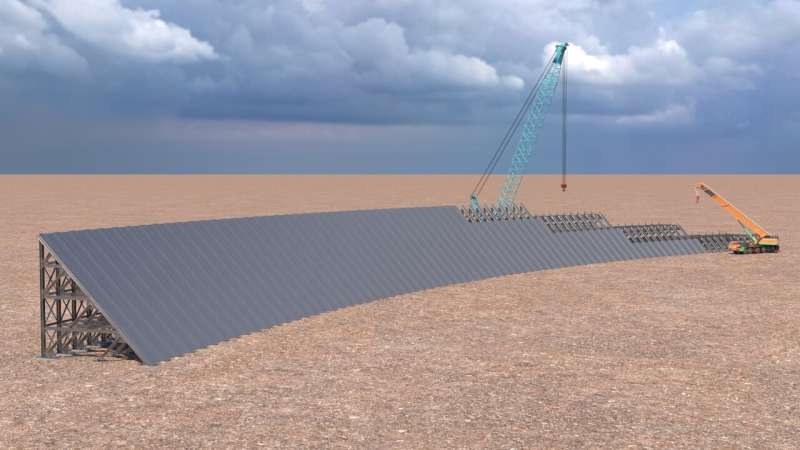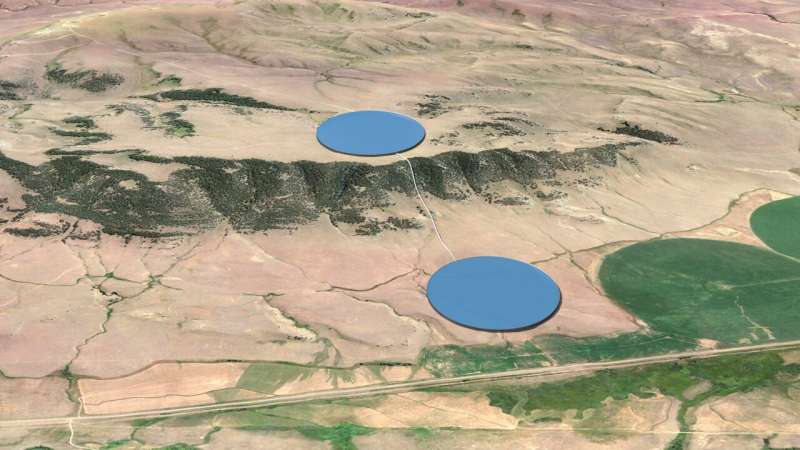This article has been reviewed according to Science X's editorial process and policies. Editors have highlighted the following attributes while ensuring the content's credibility:
fact-checked
trusted source
proofread
Modular dam design could accelerate the adoption of renewable energy

Southwest Research Institute has developed a new modular steel buttress dam system designed to resolve energy storage issues hindering the integration of renewable resources into the energy mix. The m-Presa modular steel buttress dam system facilitates the rapid construction of paired reservoir systems for grid-scale energy storage and generation using closed-loop pumped storage hydropower (PSH), cutting dam construction costs by one-third and reducing construction schedules by half.
The m-Presa system will be featured at booth 313 at the Clean Currents Conference in Cincinnati from October 10–13.
Electric power systems use PSH for load balancing. The method uses the gravitational potential energy of water, pumped from a lower-elevation to a higher-elevation reservoir using low-cost, off-peak surplus electric power to run the pumps. During periods of high electrical demand, the stored water is returned to the lower reservoir, driving turbines to produce electric power.
Although the losses from the pumping process mean it consumes more energy than it generates, the system creates value by providing more electricity during periods of peak demand, when electricity prices are highest, which mitigates the challenges associated with huge daily swings in intermittent, variable and carbon-free renewable energy, such as solar and wind power.

"Pumped storage hydropower accounts for approximately 95 percent of all energy storage in the U.S., and modern PSH plants have a round-trip efficiency approaching 80-percent," said Dr. Gordon Wittmeyer, a hydrologist in SwRI's Chemistry and Chemical Engineering Division.
"However, only one moderate-sized 40 MW PSH plant has been constructed in the past two decades in the U.S. Three factors stand in the way of rapidly deploying PSH: cost to construct, time to construct and potential environmental impacts. The SwRI-developed m-Presa system addresses all three of these issues."
Cost factors that continue to deter new investment in PSH include large capital costs—as much as $5,000 per kW installed capacity—and the lack of clear energy storage pricing signals. The m-Presa design could reduce construction costs to $1,500 per kW-installed capacity, making PSH competitive with other long-term energy storage modes.
Time to construct reservoirs is a significant cost component as well. It often takes 10 years to site, design, construct and commission a conventional PSH plant at a time when private investors are realizing paybacks of 10 years or less from subsidized solar and wind farms. Reducing the time between project initiation and revenue generation could make PSH more attractive than other solutions used to manage huge daily swings in solar generation, such as non-sustainable gas peaking plants or shorter-lived battery energy storage systems.
"We propose closed-loop pumped storage hydropower units by storing water in upper and lower reservoirs, impounded by buttress dams constructed from prefabricated structural steel modules," Wittmeyer said. "These structural steel modules can be transported on standard-sized flatbed trailers to allow rapid modular construction of 10- to 40-foot-high buttress dams that can enclose a wide range of surface areas and water volumes."
Potential environmental impacts of reservoir construction are another significant impediment to adoption of PSH when impounding a natural waterway. Potential environmental impacts associated with closed-loop PSH can be reduced or avoided if the upper and lower reservoirs are created by constructing fully enclosed dams separate from natural streams or rivers.
"The m-Presa system uses strong, long-lived steel buttress dams to create water impoundments that can store hundreds to thousands of MWhs of energy to supply power during periods of peak demand and provide ancillary services for grid stability," Wittmeyer said. "A PSH unit using the m-Presa system can be constructed in less than half the time needed for traditional PSH units that use earthen embankment or concrete dams to impound water."

















